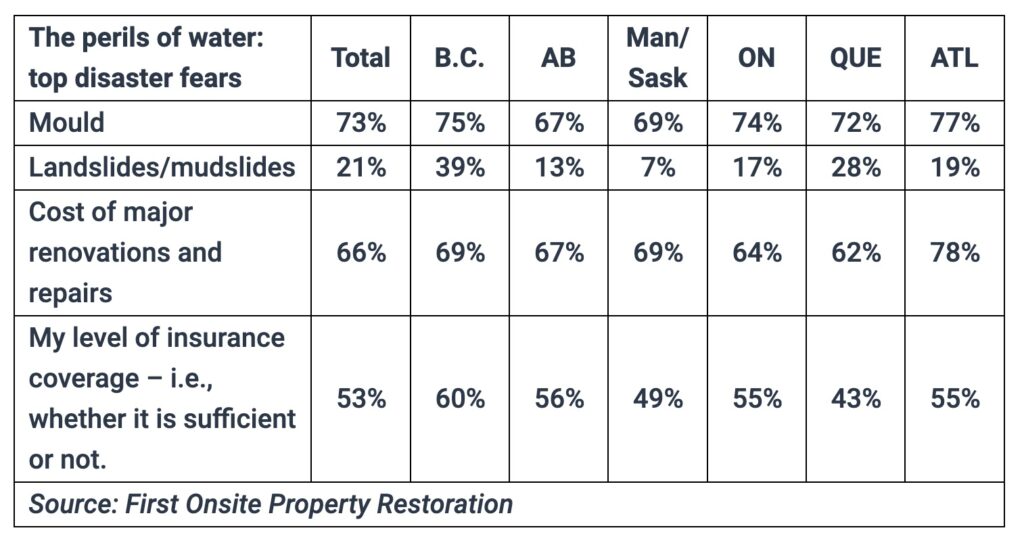
Spring flooding, mould major worries for Canadians: survey
March 15, 2023
By First Onsite Property Restoration

First Onsite Property Restoration marks the end of winter and first day of spring (next week, March 20) with the release of The Spring Melt, a survey that examines Canadians’ concerns, perceptions, and property readiness amid ever-changing weather patterns.
Commissioned by First Onsite, the survey of more than 1500 Canadian adults found that three-in-five people are worried about the damage caused by severe rains and flooding (58%).
Regional flooding concerns were highest in British Columbia (73%) which endured the historic Pacific Northwest floods in 2021. That catastrophe saw several Southern B.C. communities devastated by rain, rising rivers, road closures, and evacuations. Atlantic Canada, still reeling from Hurricane Fiona (the costliest weather event to ever hit Atlantic Canada) was the second most worried region regarding damage caused by severe rains and flooding (65%). 
“One of the biggest threats to property is flooding and water damage,” said Jim Mandeville, SVP, large loss North America, First Onsite Property Restoration. “In the spring, when the ground is still frozen, thawing snow and heavy rainfall heighten the risk of water damage to residential and commercial properties.”
Drilling down, the survey also asked people’s disaster-related concerns, and three-quarters of people responded, “I am concerned about the risk of mould after a flooding event.” Incidentally, one quarter of Canadians say their home or workplace has already been affected by mould (24%).
People were also concerned about the cost of major renovations (66%) and their level of insurance (53%). Meanwhile, twenty-one per cent of Canadians are worried about landslides and mudslides. However, B.C (39%) and Quebec (28%) are much higher than the national average, likely because they are far more prone to major landslide incidents.

“The increased occurrence of natural flooding due to weather events is a constant driver for homeowners, businesses and communities to be more resilient and better prepared for tomorrow,” said Mandeville.
Flooding in Canada
Canada’s Task Force on Flood Insurance and Relocation states that several million homes in Canada are vulnerable to flooding. Overall, flooding has accounted for 40 per cent of weather-related catastrophes in Canada since 1970 according to the Intergovernmental Panel on Climate Change (IPCC).
Some of the recent flooding events in Canada include the Calgary and Southern Alberta Flood, which happened 10-years ago in 2013. This flood cost $1.8 billion in insurance losses and an additional $6 billion in uninsured costs, according to the IPCC. Other major incidents include the 2013 Southern Ontario Flash Flood, the 2017 Quebec floods, the 2019 spring floods in Ontario, Quebec, and New Brunswick and the 2021 British Columbia floods.
Property damage caused by water related events (natural and mechanical flooding) typically accounts for nearly 70 per cent of all emergency responses for First Onsite.
Protecting property from flooding and water damage
First Onsite, a company that has been on the frontlines of high-risk situations due to climate change, natural disasters, and weather-related events, provides homeowner and business tips on preventing property water damage and protecting against the growth of mould and mildew.
Flood awareness
In the spring, when the climate transitions, and frozen ground begins to thaw, wet snow and heavy rainfall intensify the risk of water damage to residential and commercial properties:
- Water seepage through leaks in the roof or basement foundation after heavy precipitation
- Burst pipes
- Blocked or backed-up sewers and drains
- Overflow from nearby lakes and rivers
- Pooling of water from thawing snow and ice, because of slow drainage
Reducing the risk of mould growth
The excess water and moisture caused by spring showers and melting snow also leads to another hazard: mould growth, especially in dark, damp spaces. For residential and commercial property owners, it is important to be aware of the environmental triggers that feed mould growth – temperature, moisture, and a lack of ventilation.
On properties where water damage from spring flooding has occurred, mould growth poses a severe threat to the sanitation of a property.
Spring back from damage
Property damage can range from small leaks and damage to interior walls, to completely inundating buildings. If severe, water damage can even put stress on the structural integrity of a property. That’s why it’s so important to get a professional restoration team on your side the moment you notice water damage.
With the right planning and resources in place, businesses and residents can be better prepared to respond to flooding emergencies. Having resources to act quickly will also help prevent damage.
Learn more at firstonsite.ca/spring-weather/
Print this page